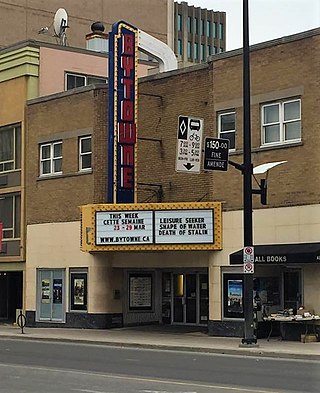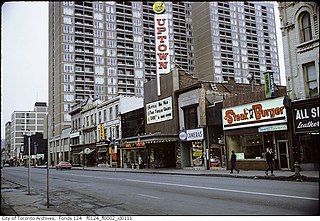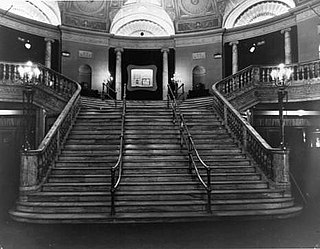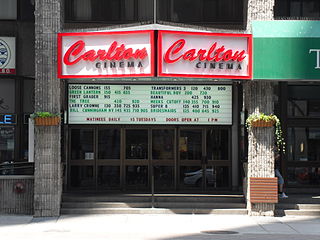

The Hollywood Theatre was a movie theatre at 1519 Yonge Street in Toronto, Ontario. [1] [2] It opened in 1930 and was located on the east side of Yonge Street, north of St. Clair Avenue. [3]


The Hollywood Theatre was a movie theatre at 1519 Yonge Street in Toronto, Ontario. [1] [2] It opened in 1930 and was located on the east side of Yonge Street, north of St. Clair Avenue. [3]
The Hollywood Theatre was the first cinema in Toronto specifically built to show talking pictures – movies with sound. It was designed by architect Herbert George Duerr, who designed it with a Moorish-style façade. As built, it contained 1,321 seats.
The building was renovated multiple times, adding a second auditorium, seating 800 patrons, in 1946. [1] According to author Doug Taylor, it became the first cinema in Canada to have more than one auditorium.
The venue was operated by the Famous Players chain. [4] In 1948, the Odeon Theatres chain built the Odeon Hyland cinema at 1501 Yonge Street, just south of the Hollywood Theatre. [2]
In 1964, the film Mary Poppins played at the theatre for 44 weeks. [5] 500,000 tickets were sold.
Famous Players closed the theatre in February 1999, and it was demolished later in 1999. [1]

Cineplex Odeon Corporation was one of North America's largest movie theatre operators and live theatre, with theatres in its home country of Canada and the United States. The Cineplex Odeon brand is still being used by Cineplex Entertainment at some theatres that were once owned by the Cineplex Odeon Corporation, with newer theatres using the Cineplex Cinemas brand. The company was the result of Cineplex Corporation in 1984 purchasing and merging with Canadian Odeon Theatres, which itself was the result of a merger between Canadian Theatres and Odeon Theatres of Canada in 1978.

Deer Park is a neighbourhood in Toronto, Ontario, Canada. It is centered on the intersection of Yonge Street and St. Clair Avenue and its boundaries are the Vale of Avoca section of Rosedale ravine in the east, Farnham Avenue and Jackes Avenue in the south, Avenue Road and Oriole Parkway in the west, the Beltline Trail in the north on the west side of Yonge Street, and Glen Elm Avenue in the north on the east side of Yonge Street. For the purposes of social policy analysis and research, the Toronto government’s Social Development & Administration division includes Deer Park within the City of Toronto's official "Rosedale-Moore Park" and "Yonge-St.Clair" neighbourhood profiles. The neighbourhood is in Ward 22, represented by Councillor Josh Matlow at Toronto City Council.

The ByTowne Cinema is a one-screen repertory movie theatre located in Ottawa, Ontario, The cinema is one of Ottawa's main venues for independent and foreign films. The 650-seat cinema is located on Rideau Street at Nelson, several blocks east of the Rideau Centre. It was closed on December 24, 2020, with a final week of screenings shown on February 26 to March 7, 2021. The cinema reopened under new ownership on September 8, 2021.

The Elgin and Winter Garden Theatres are a pair of stacked theatres in Toronto, Ontario, Canada. The Winter Garden Theatre is seven storeys above the Elgin Theatre. They are the last surviving Edwardian stacked theatres in the world.

The Ed Mirvish Theatre is an historic performing arts theatre in Toronto, Ontario, located near Yonge–Dundas Square. Owned and operated by Mirvish Productions, the theatre has approximately 2,300 seats across two levels. There are two entrances to the theatre, located at 263 Yonge Street and 244 Victoria Street.

Cineplex Inc. is a Canadian cinema and family entertainment centre chain headquartered in Toronto.
Famous Players Limited Partnership, is a Canadian-based subsidiary of Cineplex Entertainment. As an independent company, it existed as a film exhibitor and cable television service provider. Famous Players operated numerous movie theatre locations in Canada from British Columbia to Newfoundland and Labrador. The company was owned by Viacom Canada but was sold to Cineplex Galaxy LP in 2005.

The Uptown Theatre was a historic movie theatre in Toronto, Ontario which was demolished in 2003. The entrance to the theatre was located on Yonge Street just south of Bloor. Like many theatres of the time it was constructed so that only the entrance was on a major thoroughfare while the main building fronted on a side street. A bridge connected the two buildings.

The Capitol Cinema was the largest movie theatre ever built in Ottawa, Ontario, Canada, and was the city's only true movie palace. Opened in 1920, the 2530-seat cinema was regarded as one of the best cinemas designed by famed theatre-architect Thomas W. Lamb.

A multiplex is a movie theater complex with multiple screens within a single complex. They are usually housed in a specially designed building. Sometimes, an existing venue undergoes a renovation where the existing auditoriums are split into smaller ones, or more auditoriums are added in an extension or expansion of the building. The largest of these complexes can sit thousands of people and are sometimes referred to as a megaplex.
Nathan A. Taylor was a Canadian inventor and film producer. He co-founded Cineplex with Garth Drabinsky.

The University Theatre was for several decades one of the premier movie cinemas in Toronto, Ontario, Canada. It was located at 100 Bloor Street West along the Mink Mile, just west of Bay Street in an area that was once home to a number of cinemas, most notably the Uptown Theatre, and was a centre for the Toronto International Film Festival. At the time of its closing it was the largest movie house in Canada.
The Odeon Theatre Toronto was a movie theatre located at 20 Carlton Street in Toronto, Ontario. Designed by architect Jay English and operating between 1949 and 1973, the theatre was the Canadian flagship of Odeon Cinemas and one of Toronto's best examples of Streamline Moderne architecture.

The John E. Thompson block is a heritage structure at the corner of Yonge and Shuter streets in Toronto, Ontario, Canada. It was built in 1894, and renovated in 1904 and 1920. In 1900 it housed the Yonge Street Mission. According to Now Playing: Early Moviegoing and the Regulation of Fun, it was operating as a movie theatre, in the Griffin chain, in 1907.

Roxy Theatre was the final name of a theatre that operated from 1935 to 2006 at 1215 Danforth Avenue, in Toronto, Ontario, Canada's east end. It was designed by the architectural firm Kaplan & Sprachman, which designed dozens of neighbourhood cinemas, and opened under the name Allenby Theatre.

Humber Cinemas, originally the Odeon Humber Theatre, was a movie theatre in Toronto, Ontario, Canada. The theatre was operated by the Odeon and Loews Cineplex chains until 2003. The theatre re-opened as an independent theatre in 2011 and operated until 2019 when it closed permanently. The theatre was located on Bloor Street just west of Jane Street.

The Westwood Theatre was built in 1951 in Etobicoke, Ontario's Six Points intersection where Kipling Avenue intersects both Bloor and Dundas streets.

The Carlton Cinema is a cinema in Toronto, Ontario, Canada. It is located on Carlton Street on the original premises of the historic Odeon Theatre and is known for playing films that the larger chain theatres ignore.

The Paradise Theatre is a movie theatre located at 1006 Bloor Street West in the Bloorcourt Village neighbourhood of Toronto, Ontario, Canada. It first opened in 1937, closed in 2006, and then was to be turned into a pharmacy. However, it was restored and re-opened on December 5, 2019. The renovations included luxury features, such as an attached restaurant, bar, and table service to the premium patrons in the balcony.
Famous Players shuttered the Hollywood at Yonge and St. Clair in early February 1999.
In autumn of 1964 Leonard N. Bishop, manager of the Hollywood theatre on Yonge Street north of St. Clair, booked a new Disney production called Mary Poppins. The picture, which ran for a record 44 weeks and brought in more than 500,000 patrons, marked a watershed moment for not only the theatre but also for the residents of the suburban area it occupied.